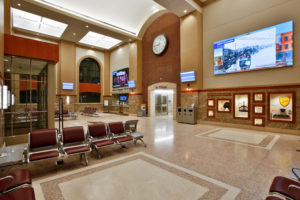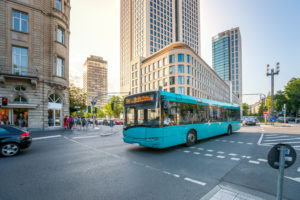In 2006, seven Wendel employees set off on a journey to learn more about what it’s like to be a passenger navigating public transportation across 12 states and 2 countries. They experienced, firsthand, the issues that affect travelers in an effort to understand how they could improve the design of public transportation facilities and enhance the experience for the traveling public. Their personal experiences combined with the information that they gathered from fellow passengers, drivers, and employees, provided them with new insight into what can be done to make public transportation a more pleasurable experience. Little did they know that their stories would allow us to develop a process where we can work with our clients prior to project startup to gather this type of information and brainstorm about ideas with all of the key players for the project. We call it Immersion™. While we might not literally travel a mile in our clients’ shoes, although this is an option, for a typical Immersion, we do follow a model that is rooted in factfinding and information gathering in order to better understand the project needs, potential roadblocks, and new opportunities.

The Odyssey’s journey involved a group of seven people, including a professional engineer, and architects who were intermodal facility designers. They undertook a seven-leg journey with each person taking one leg and traveling alone. The travelers took a journal with them in which they wrote down their experiences, and they weren’t allowed to read the others’ notes. They made their own arrangements and took a chair, simulating an awkward piece of luggage in addition to the journal. The chair also served as a means to sit and observe people and the project sites on their journey. Meeting, greeting, and being a part of public travel, our travelers met up between each leg to pass on the chair and journal, sending the next person on their way. The odyssey started in Racine, Wisconsin and ended in Petersburg, Virginia eleven days later. Only ground transportation was taken, including intercity buses, city buses, light rail, and heavy rail. While all of our travelers had different experiences, they had very similar impressions. All of them found that they had a certain level of anxiety while traveling due to lack of directions and signage. At the end of the odyssey, the travelers wrote down their collective experiences, recording their individual and shared experiences. “The pertinent factor, we realized, was the heightened anxiety level associated with not ‘knowing’ what was happening. This is true with all types of transportation but seems to be more prevalent in ground transportation facilities.” The first traveler said that they realized that they were feeling accomplished having completed their leg of the journey. The first traveler said that they couldn’t “help but have a significantly re-awakened sense of the noble service public transportation provides”.
After embarking on this journey and discovering ways in which we can help build better and more would only benefit the transit sector, but that providing our clients with more and longer access to us at the beginning of the design phase to engage in discussion about wants, needs, and potential roadblocks on a project could aid in shortening the overall time for the project, and help minimize unrealized issues, and unforeseen costs. Adding other key players like engineers, architects, landscape architects, and construction experts allows us to look at a project holistically from the very beginning. Looking at proposed sites, layouts, concepts, and budgets up front help the team identify issues, with the client that meet the program and focus on the outcome. This also helps determine a more accurate conceptual cost estimate up front. All of this led to our Immersion™ process in which we learn about and engage with our clients and stakeholders about a project in a virtual or in-person meeting over the course of a day or two. Taking the time to have these meetings face to face allows us to really get to know the issues facing our clients and stakeholders and helps the team members develop an approach to address these issues. Immersion provides us the ability to intrinsically understand our customers and clients and allows us to then take that understanding and help them in real time. The benefits are practical but also very organic because of the amount of personal connection involved.
 Today, Immersion™ is the innovative, peerless process by which Wendel works with clients at an in-person meeting. The process helps define the scope and programmatic needs of a project by being both comprehensive and inclusive, looking at a project holistically with all of the key players present. We get to know our clients and the project stakeholders on a deeper level, giving us the opportunity to provide a design that will work for them from the get-go. An Immersion™ can span anywhere from two days to a week depending on the complexity of the project. Concept design, cost estimate, design and construction schedule planning, operational considerations, retrofit options, and programmatic needs are all discussed. In addition to the client, construction managers, contractors, and estimators are involved. This provides an efficient and effective process that leaves the client with a better understanding of their project’s needs and budgetary concerns, and often includes some preliminary sketches or design conception. Clients who participate in an Immersion™ move ahead with a more comprehensive project that has already worked through risk factors, providing peace of mind that the chance of surprises is minimal. Projects that begin with an Immersion are often completed in less time and with less cost deviation than a project that followed typical design process.
Today, Immersion™ is the innovative, peerless process by which Wendel works with clients at an in-person meeting. The process helps define the scope and programmatic needs of a project by being both comprehensive and inclusive, looking at a project holistically with all of the key players present. We get to know our clients and the project stakeholders on a deeper level, giving us the opportunity to provide a design that will work for them from the get-go. An Immersion™ can span anywhere from two days to a week depending on the complexity of the project. Concept design, cost estimate, design and construction schedule planning, operational considerations, retrofit options, and programmatic needs are all discussed. In addition to the client, construction managers, contractors, and estimators are involved. This provides an efficient and effective process that leaves the client with a better understanding of their project’s needs and budgetary concerns, and often includes some preliminary sketches or design conception. Clients who participate in an Immersion™ move ahead with a more comprehensive project that has already worked through risk factors, providing peace of mind that the chance of surprises is minimal. Projects that begin with an Immersion are often completed in less time and with less cost deviation than a project that followed typical design process.
To learn more about Immersion™, click here.
To learn more about our Public Transportation Services, click here.
